Wave Management Guide: Turn Your Minions Into a 6th Team Member
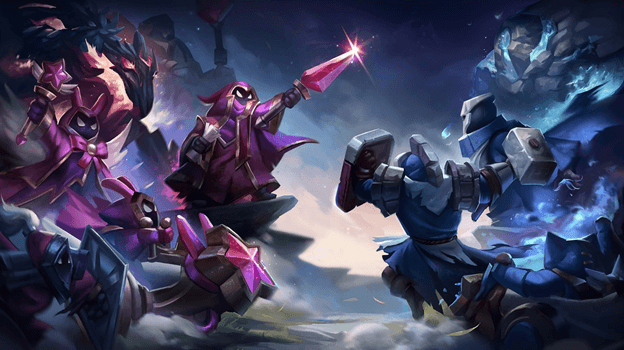
Wave management is the quiet way in which most advantages in League of Legends are gained. Wave management grants large gold and experience advantages in lane, and it also secures kills and objectives.
It is often missed since it isn’t as visible as kills and how players obtained them. But that’s also why when someone wonders how they got so far behind without realizing it, the answer will often be wave management.
So – what is wave management, why should you learn it, and how should you manage your waves? This guide will answer all these questions.
What is Wave Management?
Wave management is the strategy of controlling the minions to end up in a particular state over time. Essentially, don’t just farm; farm with purpose. This guide covers various concepts, ranging from straight-forward ones such as crashing a wave to recall to complex ones like creating a pressure point on the map.
These management strategies are mostly used to gain advantages in lane, as it’s where they are most straightforward to apply. And while the lane techniques are crucial, this isn’t the full extent of how minions can be used. First off, here is a rundown of what advantages can be gained by “farming with purpose”:
- Missing fewer minions when recalling and making the opponent lose more
- Making a tower dive stronger as well as more punishing for the opponent
- Preventing the opponent from reaching their farm (and gold) goals
- Allowing for invades and securing scuttle crabs and early drakes
- In the mid-game, removing 25% of the opponents’ available resources
- Allowing safe entry into the enemy jungle and giving Baron priority
- Creating a pressure point on a lane without needing a player’s presence
The Thought Process of Wave Management
Using minions correctly means going through three steps:
- Having a plan.
- Knowing how to execute it.
- Executing it properly.
The first part sounds simple but is, in fact, the most crucial aspect of wave management. Resorting to autopiloting when playing the game is a reflex but also a costly habit. Players should constantly think about what their game plan is. They should look forward over the next minute at least, if not longer.
In most cases, the decisions come from the central questions of “Where am I safe?”, “Which fights can I take?” and “For how long should I farm up, and when should I be somewhere else?”
From these questions comes the decision of whether to recall, dive, freeze, or roam. Let’s now get into the basics of doing wave management and how to use it to gain advantages.
Wave Management Techniques
All forms of wave management go through one of four techniques: pushing, freezing, bouncing, and stacking.
1. Pushing the Lane
Pushing the lane is the most straightforward wave operation and the most important one to be aware of. Pushing is merely killing the opposing minions as quickly as possible to send the allied wave to die to the enemy turret.
This has many applications, but even in its most basic ways, knowing when to push the lane is what makes your early game kills go from yielding 300 to 500 gold and what lets you convert favorable trades into a gold advantage.
The concept of pushing doesn’t require any explanation, as it’s simply “use what you have to kill the enemy minions as fast as possible.” There are, however, two ways to do it wrong.
First, it’s essential to not miss the last hits in the process when pushing. The goal of wave management is, in most cases, getting an advantage in gold and experience, and so missing minions in the process means sabotaging a part of the gains.
Second, the minions must reach the turret. If they don’t and meet the next enemy wave before entering the turret’s range, it’ll be the opposite of the intended goal.
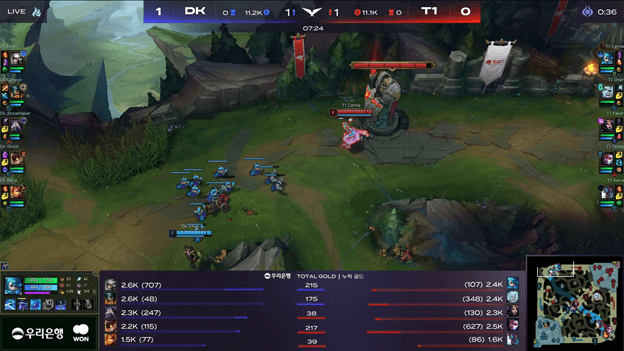
2. Freezing the Lane
Freezing the lane is the other most frequently used term when it comes to wave management. Freezing is the opposite of pushing: its goal is to keep the minions positioned at the same place while farming them. At the same time, “standard last-hitting” will by default progressively bring the waves towards the enemy turret.
As opposed to pushing, which is straightforward, freezing requires more thought and is more technical. It needs the enemy wave to be at least as big as the allied one and then goes through three concepts:
A) Attacking as Late as Possible
Instead of killing the minions as soon as one attack can kill them, freezing requires killing them when they would die during the next friendly minion’s attack. This means that the allied minions have to spend more of their time on it and cannot attack the rest of the wave until later. It also means that this enemy minion will be able to get more attacks in before dying.
B) Never getting focused by the enemy minions
When minions target a champion, they stop attacking other minions. Taking their focus will result in the enemy minions taking more damage than the allied ones, which creates a push. This is prevented by not attacking champions and by not staying too close to the wave.
C) Preventing the Enemy Minions from Reaching the Range of the Allied Turret
The goal is for the minions to die as slowly as possible, and the turret is efficient at doing… precisely the opposite! This is done in two complementary ways:
- Controlling the size of the waves, by only letting the opposing wave be two minions over the allied one. A difference of two minions allows the waves to remain locked in this state, but without killing one wave before the next one arrives. A difference of more than two minions will result in the allied wave dying too quickly and the enemy wave being able to walk up before meeting the next wave and run into the turret.
- Tanking the minions if the allied ones die too fast. Opposing minions won’t move forward if there’s a champion directly in front of them for them to target. As such, walking straight up to them will prevent them from embracing their inner lemmings and running into the turret. Doing so, however, will cost a bit of health.
3. Bouncing the Wave
Bouncing the wave is a wave management technique used in lane when having more minions than the opponent. It amounts to pushing the wave into the enemy turret to kill the excess allied minions. After this, the minions will meet in the middle of the lane again, and the opponent will have a wave that will be either identical to the allied one, or bigger.
If the allied wave is bigger, unless an opponent intervenes, it will end up on the enemy’s side of the lane and under their turret, and rather quickly so. This can make the player be in an unsafe zone. As such, bouncing the wave expediates the process and returns the wave in a state that can be manipulated.
4. Stacking Waves
Stacking waves is a combination of freezing and pushing. It’s the action of having a wave slowly grow over time (usually over 60 to 90 seconds) without moving forward and then sending it into the tower.
Stacking waves starts with a near-freeze of the lane. This can be achieved by killing or damaging one of the enemy minions immediately before applying the freezing method. This will result in the allied minions dying progressively slower, rapidly building up a big wave.
Once the wave is big enough, the second step is simply pushing to send it all into the turret. This can have three uses: buying enough time to recall and barely miss any minion, pushing the turret, or diving the opponent.
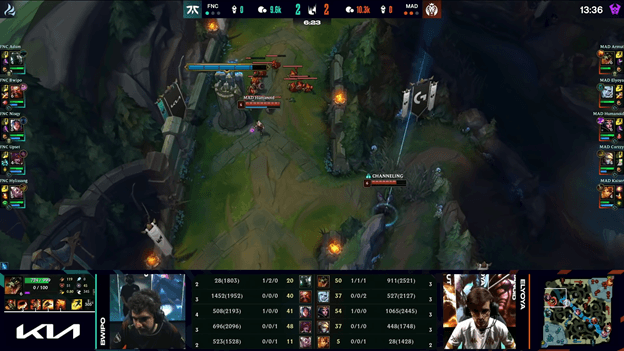
What Wave Management is Used for in League of Legends
Wave management has a variety of uses all throughout the game. The most useful ones to know about are the ones for the laning phase, as they’re the most intuitive to apply while also giving the most immediate rewards. However, the mid-late game wave management techniques will also make games easier by forcing the opponents into bad situations.
Basic Concepts
1. Laning Phase: Pushing when the Opponent is in Base
This is the most straightforward and most crucial wave management concept to possess. If the opponent is at base (be it from recalling or dying), the correct play is always to push. In most cases, this will be followed by recalling as well, though not systematically.
Pushing when the opponent is at base means that most or all of the allied minions will die under the enemy turret before they can make it back to lane, costing them a high amount of gold and experience. Early in the game, one minion wave gives ~50% of the gold and 100% of the XP granted by a kill. It’s crucial to make a habit of always doing this, as this makes the biggest “invisible” source of advantage in lane besides last-hitting.
Some champions really excel at clearing waves quickly with their abilities while others struggle. One example of great wave clearing ability is Gangplank's barrels. They can take out an entire wave all at once.
This shouldn’t be done when:
- The enemy jungler could be around. Putting the wave in a correct position is good, but it’s rarely worth dying for.
- There isn’t enough time to make the minions reach the turret by the time the enemy comes back. If the opponent is able to intercept the creeps beforehand, they are then offered a wave that they can act on however they want, including being gifted a perfect freeze. In those cases, it’s instead best to leave the wave slightly on the friendly side of the lane, in a state that will slightly push towards the allied turret. The goal is to have the minions stay in a safe place without being killed by the turret.
Note for Junglers: As a jungler, it’s vital to help the laner push after a gank or when they want to recall. In general, junglers should be aware of wave management to understand the states of the lanes and act accordingly.
2. Laning Phase: Freezing to Deny Farming
The second most basic concept of wave management; at this stage of the game and of people’s understanding of it, players are expected to know how and when to freeze and push as part of the lane skillset.
In the laning phase, the point of freezing is to keep all minions on the friendly half of the map. This is the place where it’s safest to be – the proximity of the turret prevents the enemy player from continuing trades, sometimes straight-up prevents them from initiating them too, and it also makes it least likely for an enemy gank to be successful.
But at the same time, this also gives the opposite effect for the enemy. The wave being in this territory can prevent the opponent from farming and make it impossible for them to fight, as trying to reach the minions puts them in a vulnerable position while also exposing them to ganks.
This means that freezing is useful when ahead or when the opponent doesn’t know where the jungler is.
- If a player is ahead and freezes their lane, the opponent is forced to wait and concede farm, as they could get killed for moving up to the wave. In the best cases, they can even be forced out of experience range. An added bonus is that a player in this situation will sometimes walk up anyway, out of frustration or acting against their self-interest, and donate a welcome kill.
- Even without being ahead, as long as the opponent can’t know where the jungler is, a frozen lane forces them to risk getting ganked or abandon the farm.
This technique isn’t as useful out of these situations, as the opponent can then simply walk up to the lane and push it into the turret, breaking the freeze.
There are two things to watch out for when doing this (additionally, those are two options to think about when facing this situation).
- In a frozen lane, ideally, the opponent isn’t getting any resources. This means that they could roam and not lose any more resources than they already are. In doing so, they can influence the rest of the map while being in a spot where they should have less impact.
- For the same reason, they can also leave the lane to take the nearby jungle camps and reduce the resource advantage.
Lastly, the easiest thing to do with a freeze when needing to recall or leave lane is to quickly push the wave before leaving it.
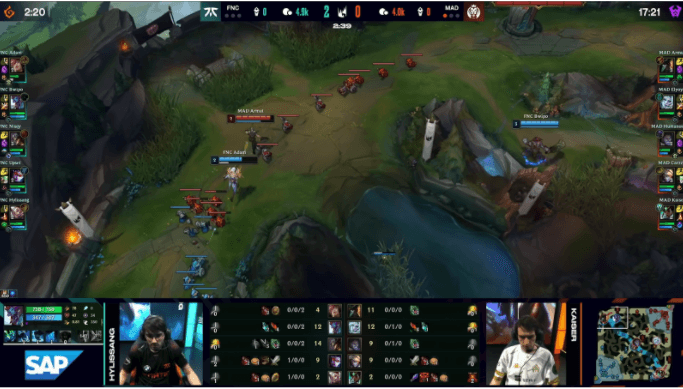
3. Laning Phase: Pushing for Drake
This wave management concept will introduce one of the important consequences of pushing: granting lane priority, a principle that will be used by other wave management concepts as well. A player or duo that has their lane pushed forward can:
- Move quicker
- Move into fog of war
- Move without losing resources
This means that the lane with priority will arrive at the objective first, can ambush the other team if they try to follow, and forces their counterpart to pay a major minion price if they decide to do it. This often results in the opponent simply not being able to match the movement.
Due to this, pushing in mid and bot when the jungler is nearby allows securing the Drake easily. The same thing can be done in mid and top for the Herald, but this isn’t as necessary as it’s less contested and easier to take alone than the Dragon is.
4. Laning Phase: Bouncing to Avoid Ganks
This is an effortless application of pushing. The more forward someone is in lane, the more likely they will get ganked, and the more likely that gank will be successful. As a result, whenever being too far up in lane, it’s important to actively think about what could happen and where the enemy jungler could be. If nothing indicates that they can’t gank the lane, it’s best to not stay in this exposed situation.
The way to do so without losing out is to bounce the wave. Pushing it into the turret, backing off as soon as it’s far enough, staying back as the tower does its job to stay safe while there’s nothing to gain, and resuming normal business once the waves meet in the center of the lane again.
Note: You can also use that idle time to recall to stock up on resources and items at a minimal cost.
Advanced Concepts for Managing Waves
1. Laning Phase: Stacking Waves for Dives
What differentiates the advanced wave management concepts from the basic ones is that they require more of a plan. In contrast, the basic ones result from direct observation of the lane’s current state and the immediate future.
Stacking waves is usually planned a full minute in advance and often relies on the jungler or mid laner being in on the plan as well, though you can do it alone in some situations.
This technique consists of nearly freezing the lane for a few waves before suddenly pushing as a new wave arrives. While this can be used as a stronger version of pushing (to recall or for priority), its most menacing use is for tower dives.
If someone dies under their turret while there are 13 minions in front of it, they will lose an extreme amount of gold and experience. At level 6, it’s about 90% of a kill’s gold and 155% of its experience. That makes these plays very rewarding to pull off. It even means that a trade kill under the enemy turret under these circumstances is also precious, which is why this is an excellent solo play as well.
However, this wave management concept is also risky. It requires being aware of the position of the enemies, as the enemy turret is a horrible place to get counter ganked under.
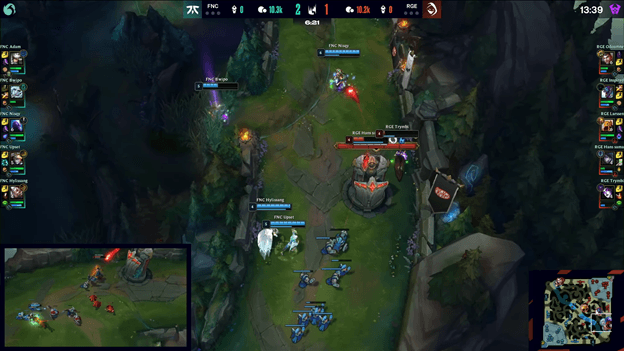
2. Pushing for Map Presence
This is the simplest of the advanced concepts. It’s best used by mid-lane throughout the game, but the side lanes make excellent use of it as well after taking their turret.
Pushing gives rotation priority and allows to be away for a specific time missing little to no resources. As such, it allows to:
- Invade alongside the jungler
- Gank another lane
- Take one jungle camp
This is always an option to consider, especially in mid where freezing is less possible. Pushing gives the jungler more freedom, and tag-team plays can set the opposing jungler severely behind.
For side lanes, an easy way to progressively get a resource lead after taking the turret is by constantly pushing then taking the closest jungle camp. However, this requires having good vision coverage, as these areas are very vulnerable to ganks.
3. Early Game: Pushing for Crabs
Nowadays, junglers commonly fight over the scuttle crab at 3:15 – whether they should or not. The mid laner and the side laner on that half of the map can make this much easier (and turn it into advantages) by preparing ahead of time and pushing their lane before the 3-minute mark so that they can have lane priority to secure the numbers advantage in the potential fight.
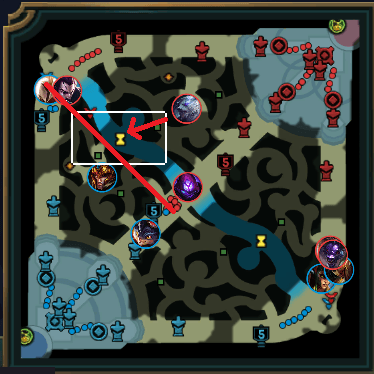
Nowadays, junglers commonly fight over the scuttle crab at 3:15 – whether they should or not. The mid laner and the side laner on that half of the map can make this much easier (and turn it into advantages) by preparing ahead of time and pushing their lane before the 3-minute mark so that they can have lane priority to secure the numbers advantage in the potential fight.
4. Mid-Late Game: Pushing for Baron
This concept will use minions as a source of vision and as a pressure point. Wards grant vision, but the position of the minion waves on the map also determines how much each team can see. The further up the waves, the earlier the enemy movements can be seen, and the more the allied activities stay hidden.
That makes it necessary to push all three lanes (and mid lane most of all) as a setup for attempting a Baron or Elder Dragon.
Additionally, a team positioning around Baron often forces their opponents to stay around for a while without the objective being started. During that whole time, if the bot lane minions are pushing, nobody can take care of them without conceding the numbers advantage for the Nashor. This still means minions lost for the opponents, but at this stage of the game, it also means that their structures will take significant damage from the pushing wave.
Expert LoL Wave Management Concepts
1. Laning Phase: Blocking Off Wave Access
The expert concepts either come with significant risks if they aren’t done in the proper circumstances or require even more planning and discipline.
This one is in the former category. One of the most powerful snowballing techniques for side lanes, also coming with the most risks without proper vision or even execution. You can do it either alone or with a teammate assisting.
This technique starts with pushing the wave after killing the opponent or making them recall. However, the next step is to move further forward, take out the next minion wave before it can reach the turret, and stay there.
This tactic blocks the opponent and prevents them from reaching their turret, where the allied minions are currently dying. It makes them miss the gold and experience, and if they’re careless, they can even easily die, as they don’t have their turret’s protection.
The risks there are to get ganked (due to being far into enemy territory), or even to die in 1v1 because of the health and cooldowns used to clear the minions, but doing this with a teammate makes it a safer play.
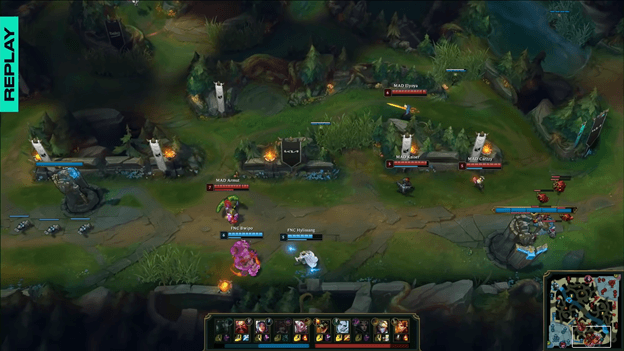
2. Mid game: Freezing Side Lanes
This wave management concept is known for being very controversial. It is indeed the other riskier technique. This is normally done on a side lane after the first turret fell, and consists in holding the wave just in front of the turret.
This can be done theoretically forever and practically for entire minutes. It means that the enemy team fully loses access to one of their four resource spots for as long as the freeze is going on. However, it also means playing one person down over that same period.
3. Pushing for Vision
The final wave management technique isn’t a risky one to execute – if anything, it’s about playing the game safely and methodically. But it requires sticking to a team-wide plan against many temptations of deviating from it.
Warding the enemy jungle is one of the most critical aspects of snowballing, and it’s also an easy way to die for no reason when done carelessly. The proper way to ward is to ensure that the enemies won’t be there to intercept the person warding (or at least in insufficient numbers).
The best method to set up control over the map is through wave management: it consists of pushing all lanes (or at least the two lanes in the critical area) to have the minions give vision. The next step is to move into the jungle in groups to set a layer of wards and to contest the enemy vision.
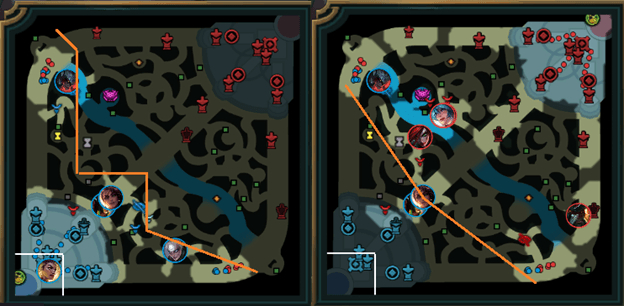
Final Thoughts on Wave Management in LoL
This guide should have covered all the techniques for effective wave management in League of Legends and how and when to execute them. Proper wave management generates the most significant unseen advantages in LoL, making these important to keep in mind.
Please let us know what you think about this League of Legends guide using the comments section below. See you on the Rift!
Images Courtesy of Riot Games.
